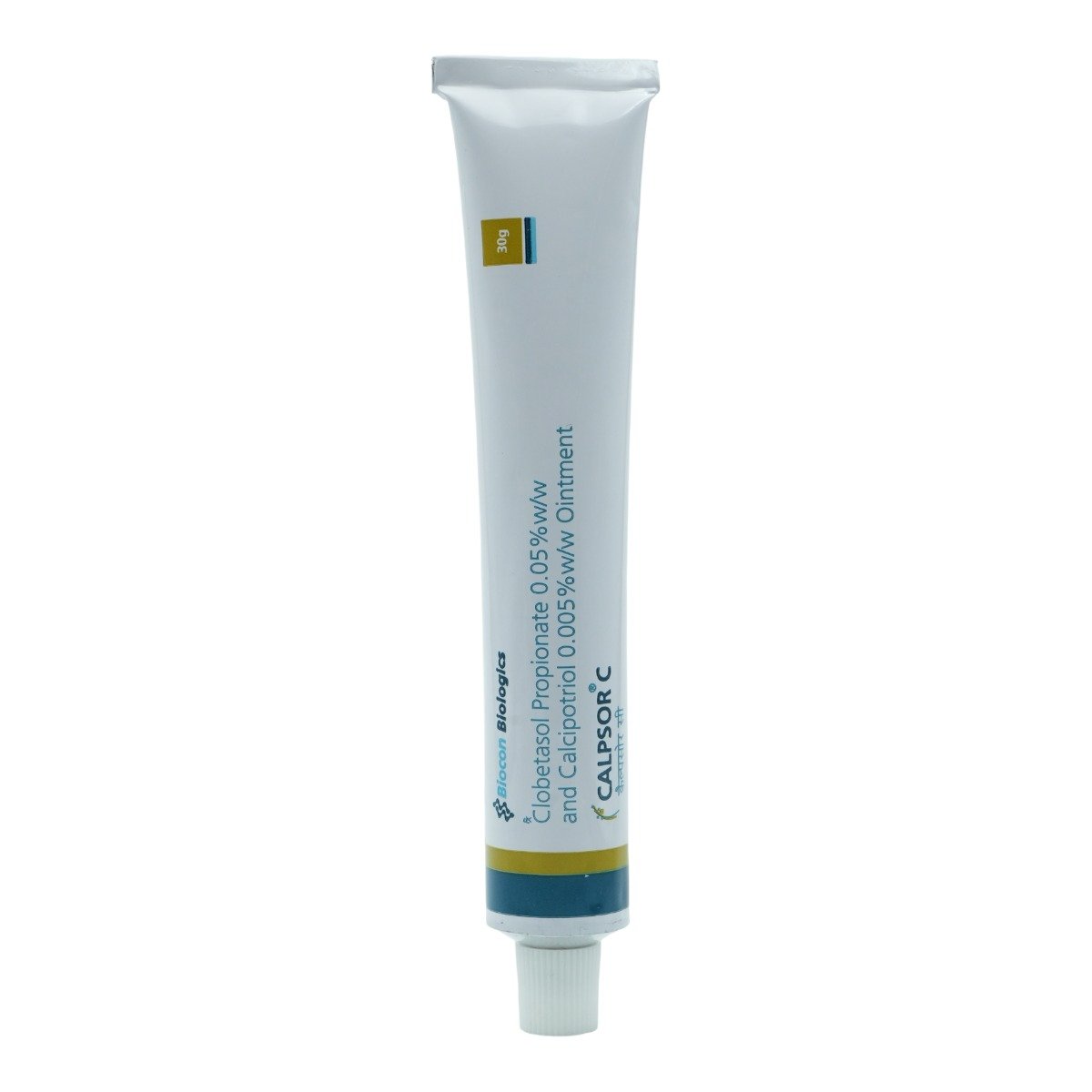Soronil-C Ointment 20 gm
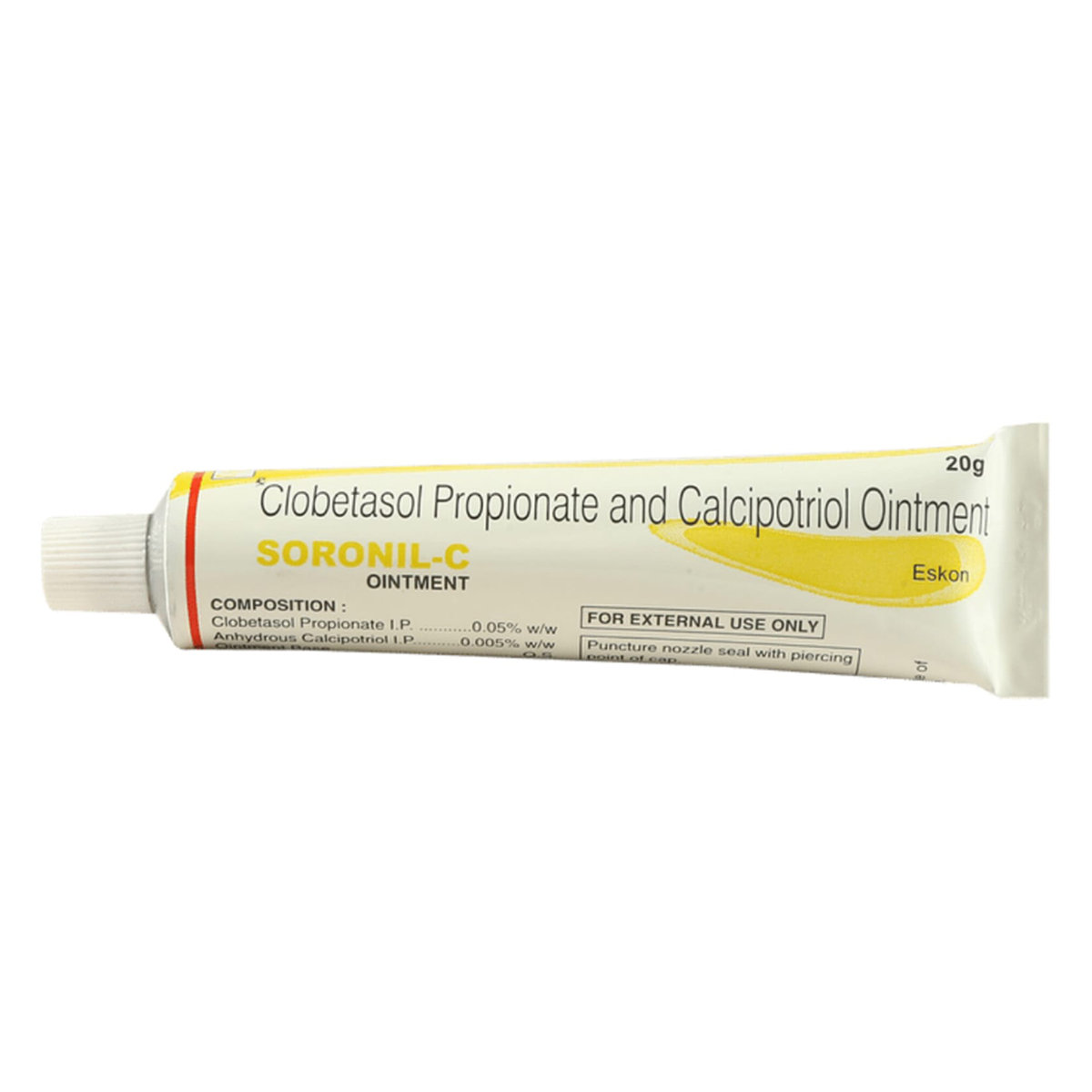
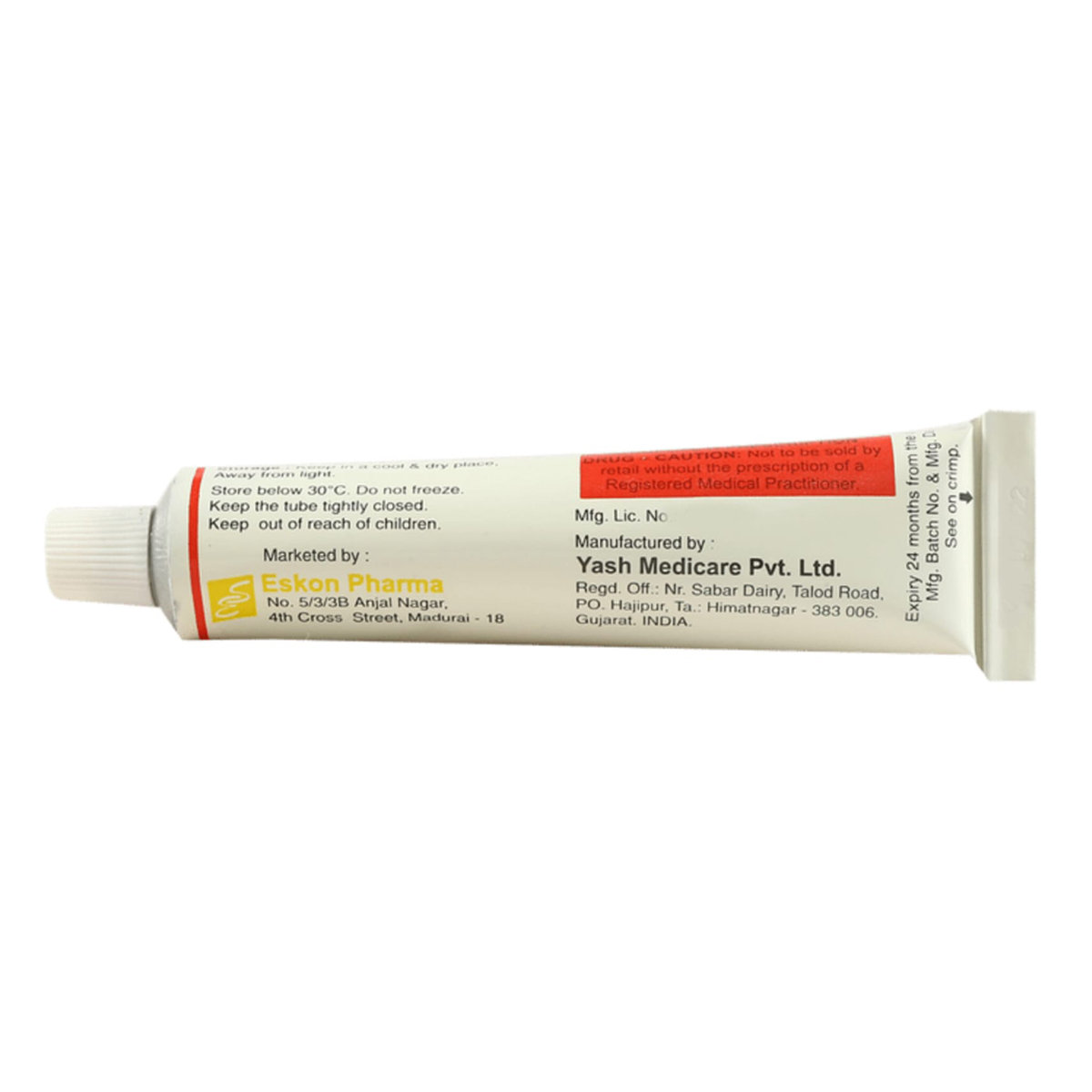
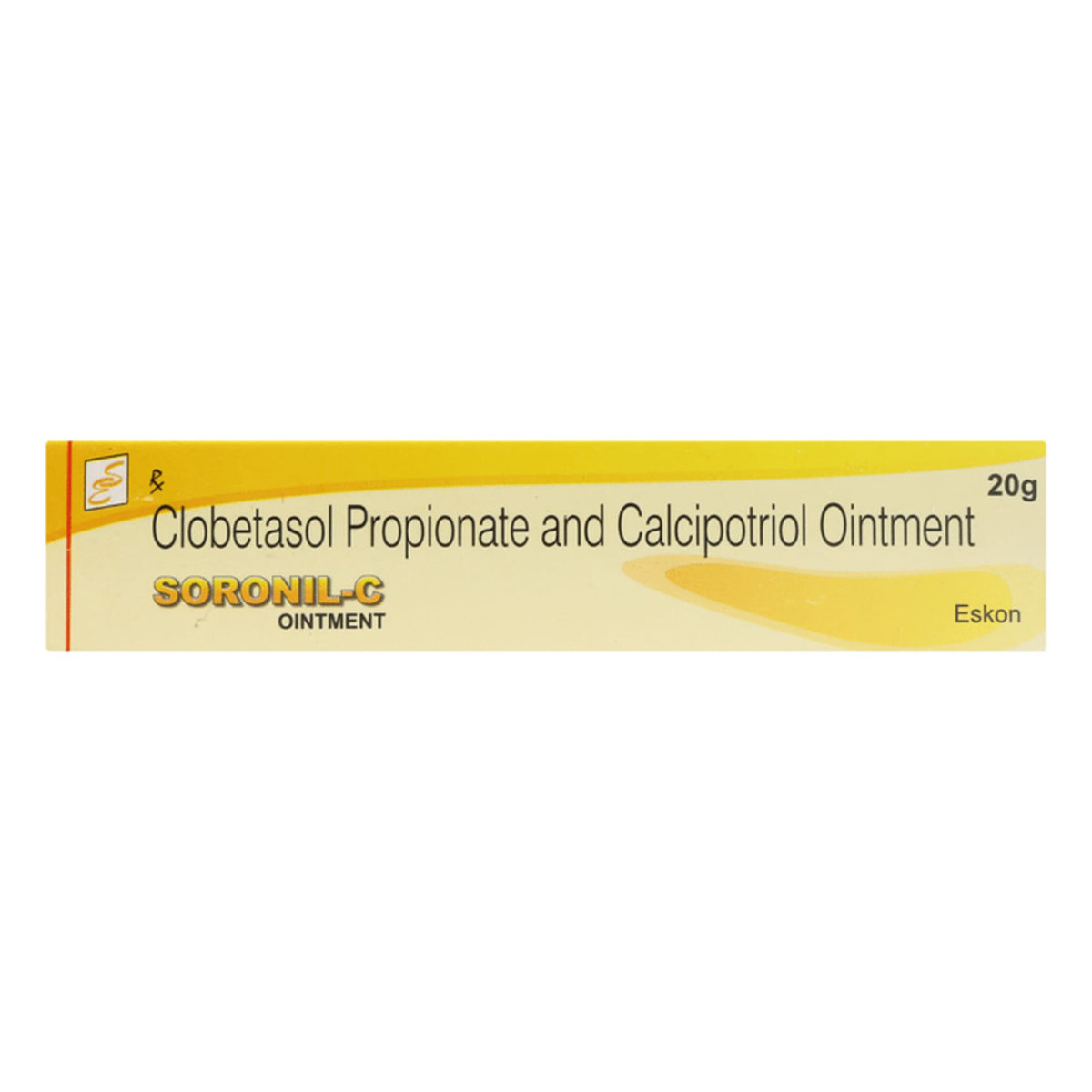
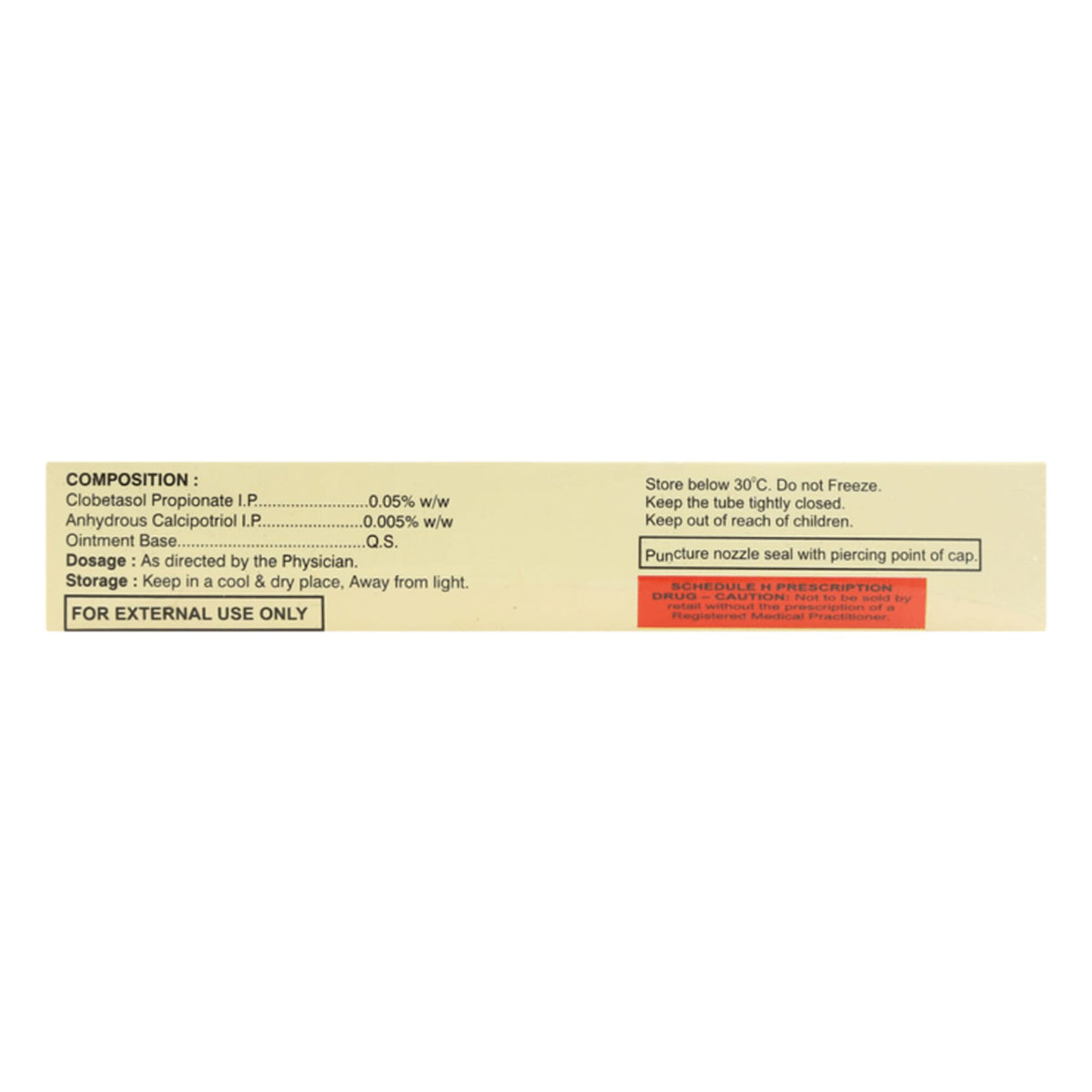




MRP ₹384
(Inclusive of all Taxes)
₹57.6 Cashback (15%)
Provide Delivery Location
Online payment accepted
 Prescription drug
Prescription drugWhats That
Composition :
Manufacturer/Marketer :
Consume Type :
Return Policy :
Expires on or after :
About Soronil-C Ointment
Soronil-C Ointment belongs to the class of 'antipsoriatic agents', primarily used to treat psoriasis. Psoriasis is a skin disorder in which skin cells multiply and form bumpy (uneven) red patches covered with white scales. These red patches can commonly appear on the scalp, elbows, knees and lower back.
Soronil-C Ointment consists of two medicines, namely: Clobetasol (corticosteroid) and Calcipotriol (synthetic Vitamin D). Clobetasol is a highly potent 'corticosteroid' with anti-inflammatory, antipruritic (relieves itching) and vasoconstrictive (narrows blood vessels) properties. It blocks the production of prostaglandins (chemical messengers), which make the skin red, swollen and itchy. On the other hand, Calcipotriol (also known as calcipotriene) is a man-made form of Vitamin D that belongs to the class of antipsoriatic agents. It helps in the inhibition of the overproduction of skin cells. It is used to treat plaque psoriasis (psoriasis vulgaris), a condition that develops thick red patches on the skin with a silver or white scaly layer.
Use this medication on the skin only as advised by the doctor. Soronil-C Ointment is generally safe to use. Some may experience common side effects like itching, redness, stinging sensation, dryness and rash. These side effects do not require medical attention and gradually resolve over time. If these side effects persist longer, please consult your doctor.
Avoid contact with your eyes, nose or mouth while using Soronil-C Ointment. Rinse it off with water thoroughly if you get the cream in these areas. Brief your medical history to the doctor if you are allergic to Soronil-C Ointment or any of its components. Let your doctor know if you have any active skin infections before using Soronil-C Ointment. Pregnant and breastfeeding women should use Soronil-C Ointment only with proper consultation and caution. Soronil-C Ointment is not recommended for children less than 12 years of age.
Uses of Soronil-C Ointment
Directions for Use
Medicinal Benefits
Soronil-C Ointment treats psoriasis and is a combination of two medicines: namely: Clobetasol and Calcipotriol (also known as calcipotriene). Clobetasol is a corticosteroid medicine. It blocks the production of prostaglandins (chemical messengers), which make the skin red, swollen and itchy. Calcipotriol is a man-made form of Vitamin D that is an antipsoriatic agent. It inhibits the excess production of skin cells that leads to the formation of scales and patches of the skin in psoriasis. Soronil-C Ointment helps treat plaque psoriasis, a most common type of psoriasis that develops thick red patches on the skin, with a silver or white scaly layer.
Storage
- Avoid medications that led to lesions and seek medical advice immediately.
- Prefer loose, comfortable clothing made from breathable fabrics to reduce irritation around lesions.
- Moisturize frequently to keep the skin hydrated and prevent further irritation.
- Do not scratch the affected area to prevent worsening the rash and leading to severe infection.
- Relax and manage stress to help your body recover from the underlying cause of the rash.
- Do not get exposed to irritants like soaps, detergents, or extreme temperatures.
- Avoid scratching the affected area.
- Wear loose clothing to reduce irritation.
- Keep the affected area moisturized with a gentle moisturizer.
- To alleviate the reaction, remove the irritant by immediately stopping contact and washing the area with mild soap and cool water.
- Apply a cool, wet compress to reduce inflammation and itching.
- Consult a doctor if your skin reaction is severe, widespread, or accompanied by swelling, blistering, or breathing difficulties.
- Skin rash caused by allergies is due to irritants or allergens. Therefore, avoid contact with such irritants.
- Consult your doctor for proper medication and apply an anti-itch medication. Follow the schedule and use the medication whenever needed.
- Protect your skin from extreme heat and try to apply wet compresses.
- Soak in the cool bath, which gives a soothing impact to the affected area.
- Get ample rest; this helps your stomach to settle.
- Eat soft and easy-to-digest foods like white rice, bananas, crackers and apple sauce.
- Include probiotics-rich food like yoghurt, kefir, or miso, as they help maintain gut functioning.
- Wash your hands properly before preparing/eating food and after using the toilet.
- Drink water, broth or diluted fruit juice to replace electrolytes and lost fluids.
- Avoid caffeine, alcohol, high-fat, fried and fast foods, as well as sweetened beverages.
- Stay hydrated by drinking plenty of water to help flush out crystals and prevent their formation.
- Limit intake of foods high in oxalate, such as spinach, beets, and rhubarb, which can contribute to crystal formation.
- Increase consumption of foods rich in citrate, such as citrus fruits and juices, which can help prevent crystal formation.
- Avoid excessive intake of animal proteins, sodium, and sugar, which can increase the risk of crystal formation.
- Maintain a healthy weight and engage in regular physical activity to reduce the risk of developing kidney stones and Crystalluria.
- Consult a healthcare professional or registered dietitian to develop a personalized plan to manage Crystalluria and prevent recurrence.
- Burning sensation is an abnormal side effect that needs medical attention. To relieve the burning feeling, your doctor may prescribe painkillers or antidepressants.
- Focused exercises can improve strength and reduce burning by soothing muscles.
- Change in lifestyle and improving nutrition can reduce the causes of burning sensation and provide relief.
- Your doctor may suggest nerve block injections as it is related to sensation in the skin.
- Burning feeling in a specific area would need mild electrical currents to reduce pain that targets the nerve affected. This practice must be done only if your doctor mentions it.
Drug Warnings
Brief your medical history to the doctor, if you are allergic to Soronil-C Ointment or any of its components. Therapy with topical corticosteroids like Clobetasol should be administered cautiously in patients with bacterial, fungal, viral and protozoa infections. Soronil-C Ointment is not recommended for diaper rash. If you are pregnant or breastfeeding, you should use Soronil-C Ointment only with proper doctor consultation and caution. Soronil-C Ointment is for external use only. Avoid contact of Soronil-C Ointment with eyes, nose and mouth. Rinse it off with water thoroughly if you get the cream/ointment in these areas. Do not put a bandage or a dressing on the affected area while using Soronil-C Ointment unless advised by the doctor. Always wash hands before and after the application of Soronil-C Ointment. Do not store Soronil-C Ointment above 25°C.
Drug-Drug Interactions
Drug-Drug Interactions
Login/Sign Up
Drug-Food Interactions
Drug-Food Interactions
Login/Sign Up
Diet & Lifestyle Advise
- Use mild soap while taking baths and prefer warm baths.
- Always wear loose-fitting clothes to avoid further sweat and spread of the infections.
- Regularly change your socks and wash your feet. Avoid shoes that make your feet sweaty and hot.
- Do not walk barefoot at places like gym showers to prevent infections.
- Do not scratch the affected area of skin as it can spread the infection to other body parts.
- Avoid sharing towels, combs, bed sheets, shoes or socks with others.
- Wash your bed sheets and towels regularly.
- Avoid or limit the intake of alcohol and caffeine.
- Do not scratch or pick your skin to avoid getting the affected area infected.
- Manage stress, eat healthily, drink plenty of water, exercise regularly and sleep peacefully.
Side Effects of Soronil-C Ointment
- Itching
- Redness
- Stinging sensation
- Dryness
- Rash
Habit Forming
Therapeutic Class
All Substitutes & Brand Comparisons
RX
Out of StockTovilog C Ointment
Citaderm Pharma Pvt Ltd
₹590
(₹17.7/ 1gm)
2% COSTLIERRX
Out of StockSoritrol C Ointment
₹311
(₹18.66/ 1gm)
7% COSTLIERRX
Calpsor C Ointment 30 gm
Biocon Ltd
₹668
(₹19.59/ 1gm)
13% COSTLIER
Product Substitutes
Author Details
We provide you with authentic, trustworthy and relevant information
Drug-Diseases Interactions
Drug-Diseases Interactions
Login/Sign Up
FAQs
Soronil-C Ointment is composed of Clobetasol, a steroid and Calcipotriol, an antipsoriatic agent. These two medicines help in treating the red bumpy patches and relieves itchiness and redness at psoriasis affected areas.
Soronil-C Ointment is for topical (for skin use) application only. Avoid Soronil-C Ointment contact with eyes, nose and mouth. Do not put a bandage or a dressing on the affected area while using Soronil-C Ointment unless advised by the doctor.
Soronil-C Ointment can make your skin more sensitive to the harmful effects of the sunlight. Hence it is advised to use sunscreen and wear protective clothing while using Soronil-C Ointment. It is also recommended to avoid tanning booths and sunlamps.
Soronil-C Ointment is used only for the treatment of psoriasis. It is not recommended for diaper rash. Your baby's paediatrician will suggest other medicines for the treatment of diaper rash.
Do not stop using Soronil-C Ointment even if you feel better until the doctor's advised course is finished. Your symptoms may improve, but the disease may not be cured completely.
Special Advise
- Monitor your blood sugar levels and blood pressure regularly while using Soronil-C Ointment.
- If you do not notice any improvement of your infection after using Soronil-C Ointment for one to two weeks, please consult your doctor.
Disease/Condition Glossary
Psoriasis: It is a skin disorder in which skin cells multiply and form bumpy (uneven) red patches covered with white scales. These red patches can commonly appear on the scalp, elbows, knees, and lower back. Psoriasis is a noncontagious (not spread by contact), chronic immune condition with no cure. It can be mild, moderate and severe based on the patches coverage on the skin. People with 80-90% suffering from psoriasis have plaque psoriasis. Psoriasis can be pustular, guttate, inverse and erythrodermic. Pustular psoriasis mainly covers palms of the hands and soles of the feet. Guttate psoriasis usually starts in childhood or young age and affects the torso and limbs. Inverse psoriasis forms bright red lesions in armpits, groin and under the breasts. Erythrodermic psoriasis is triggered by sunburn, infections and certain medications that cause redness and shedding of the skin.

Have a query?
Buy best Dermatology products by
Others
AYUR
FIXDERMA
BIODERMA
VENUSIA
CANDID
SELSUN
ABZORB
ATODERM
CIPHANDS
KETO
MINTOP
UVAVO
8X
MELALUMIN
MORR
OILATUM
REJUHAIR
SUNCROS
TETMOSOL
UNISON
UV DOUX
ATBRO SAFEXX
BETADINE
COLOPLAST
DR. MOREPEN
HAIR 4U
LA SCREEN
MEDERMA
RING GUARD
SHYN-ON
SOLSET
SUNSTOP
YUVINIE
A-DERMA
AHD
ALCONANZ
AQUAHOLD
AVARTA
AVENE
BIOLINE
BIOWRIGHT
CETRILAK
CUTICOLOR
CUTILOCK
DANDEL PLUS
DEOPHIN
DOUX
DYSIS
ENMASK 50
EXIZOL
FAIR INSTA
GETRYL
GORGEUS
GUNEERA
HAIR YUTH
HH MITE
I-GLOW
ITCH GUARD
KETOFLY
KETOMAC
KETOPZ
KETOSTAR
KZ
LIPZ
MANKIND
MEDRAYS
MELAGARD
MELNORA BLUV
MICROSTERILE
NO SCARS
OAKNET
ONABET
PARASOFT
PERCOS
PHOTON
PHOTOSTABLE
PHYSIOGEL
PROTEK
RADIBAN
RASHFREE
REGALIZ
RENOCIA
SALISIA
SEBANDRO
SEBORBAR
SESTRY
SOLASAFE
SOLECROSS
STERILLIUM
SUDERMA
SUN KROMA
SUNCLIP
SUNHEAL
SUNMATE
SUNTRIS
TAIYU
TEDIBAR
THERUPTOR
TRICOGRO
Glenmark Pharmaceuticals Ltd
Sun Pharmaceutical Industries Ltd
Klm Laboratories Pvt Ltd
Cipla Ltd
Canixa Life Sciences Pvt Ltd
Abbott India Ltd
Ajanta Pharma Ltd
Intas Pharmaceuticals Ltd
Dr Reddy's Laboratories Ltd
East West Pharma India Pvt Ltd
Alkem Laboratories Ltd
Atopic laboratories Pvt Ltd
Hegde & Hegde Pharmaceutica Llp
Brinton Pharmaceuticals Ltd
Torrent Pharmaceuticals Ltd
Amwill Healthcare Pvt Ltd
Leeford Healthcare Ltd
Palsons Derma Pvt Ltd
Oaknet Healthcare Pvt Ltd
Med Manor Organics Pvt Ltd
Micro Labs Ltd
Dermocare Laboratories Gujarat Llp
Fixderma India Pvt Ltd
Apex Laboratories Pvt Ltd
Mankind Pharma Pvt Ltd
Ipca Laboratories Ltd
Yaher Pharma
Systopic Laboratories Pvt Ltd
Menarini India Pvt Ltd
Ethinext Pharma
Nemus Pharmaceuticals Pvt Ltd
Skinocean Pharmaceuticals
Dermacia Healthcare
Inex Medicaments Pvt Ltd
Lupin Ltd
GlaxoSmithKline Pharmaceuticals Ltd
Talent India Pvt Ltd
Zydus Cadila
Kivi Labs Ltd
Zydus Healthcare Ltd
Hbc Dermiza Healthcare Pvt Ltd
Mrhm Pharma Pvt Ltd
Regaliz Medicare Ltd
Sol Derma Pharmaceuticals Pvt Ltd
Newtrimed Healthcare Pvt Ltd
Wallace Pharmaceuticals Pvt Ltd
Eskon Pharma
Glowderma Lab Pvt Ltd
La Pristine Bioceuticals Pvt Ltd
Mohrish Pharmaceuticals Pvt Ltd
Percos India Pvt Ltd
Rockmed Pharma Pvt Ltd
Macleods Pharmaceuticals Ltd
Praise Pharma
Ethicare Remedies Pvt Ltd
Kaizen Drugs Pvt Ltd
Aurel Biolife
Rely On Pharmaceuticals
Wockhardt Ltd
Galcare Pharmaceuticals Pvt Ltd
Elder Pharmaceuticals Ltd
Indiabulls Pharmaceuticals Pvt Ltd
La Med Healthcare Pvt Ltd
Biocute Life Care
Yap Bioceuticals
Yash Pharma Laboratories Pvt Ltd
Zee Laboratories Ltd
Apple Therapeutics Pvt Ltd
Adonis Laboratories Pvt Ltd
Albatross Healthcare Pvt Ltd
Galderma India Pvt Ltd
Prism Life Sciences Ltd
FDC Ltd
Alniche Life Sciences Pvt Ltd
Salve Pharmaceuticals Pvt Ltd
West Coast Pharmaceuticals Pvt Ltd
Dermarex HealthCare India Pvt Ltd
Arka Vital Science Pvt Ltd
Dermajoint India
Gary Pharmaceuticals Pvt Ltd
Grace Derma Healthcare Pvt Ltd
Karlin Pharmaceuticals & Exports Pvt Ltd
Skinska Pharmaceutica Pvt Ltd
Uniza Healthcare Llp
Alembic Pharmaceuticals Ltd
Cadila Healthcare Ltd
Cadila Pharmaceuticals Ltd
Cosmofix Technovation Pvt Ltd
Human Pharmaceuticals
Indolands Pharma Pvt Ltd
Lyra Laboratories Pvt Ltd
Akumentis Healthcare Ltd
Entod Pharmaceuticals Ltd
Iceberg Health Care Pvt Ltd
Jenburkt Pharmaceuticals Ltd
P and P Dermaceuticals Pvt Ltd
Dabur India Ltd
Indchemie Health Specialities Pvt Ltd
Olcare Laboratories Pvt Ltd
Unison Pharmaceuticals Pvt Ltd
BODY CREAM
Body Lotion
Face Cream
Shampoo
Sun Screen
Face Gel
Soap
Face Wash
HAIR SOLUTION
Face Serum
BODY GEL
Hair Lotion
Hair Serum
Dusting Powder
ANTISEPTIC
FACE CLEANSER
Face Lotion
Body Wash
Body Spray
Eye Cream
FUNGAL INFECTION
Foot Cream
Conditioner
Eye Gel
Cleanser
Hair Cream
Hair Oil
Face Mask
Hair Gel
Sanitizer
Hair Spray
Moisturiser
Skin Ointment
Lip Balm
Capsule
Eye Serum
Intimate Wash
Specialty Supplements
Hand Cream
Facial Spray
SPECIALITY SUPPLEMENT
Face Toner
MEDICATED SHAMPOO
Tablet
Talcum Powder
BABY SUNSCREEN
Body Butter
Body Scrub
DIAPER RASH CREAM
EYE SOLUTION
FACIAL WIPE
Gargle
Hand Wash
Intimate Spray
Lip Serum
Lubricant Gel
MEDICATED CREAM
Nail Polish
VITAMIN D
Alcohol
Caution
No interaction found of Soronil-C Ointment with alcohol.
Pregnancy
Caution
There is limited data on how the Soronil-C Ointment affects pregnancy. Please consult your doctor if you are planning to become pregnant or already pregnant before starting Soronil-C Ointment.
Breast Feeding
Caution
It is not known if Soronil-C Ointment passes into the breast milk. Please consult your doctor before using Soronil-C Ointment if you are breastfeeding.
Driving
Safe if prescribed
There have been no studies to investigate the effect of Soronil-C Ointment on driving performance or the ability to operate machinery.
Liver
Caution
Let your doctor know if you have any history of liver diseases before using Soronil-C Ointment. Your doctor will weigh the benefits and potential risks before prescribing Soronil-C Ointment.
Kidney
Caution
Let your doctor know if you have any history of kidney diseases before using Soronil-C Ointment. Your doctor will weigh the benefits and potential risks before prescribing Soronil-C Ointment.
Children
Caution
Soronil-C Ointment is not recommended for children less than 12 years of age.



